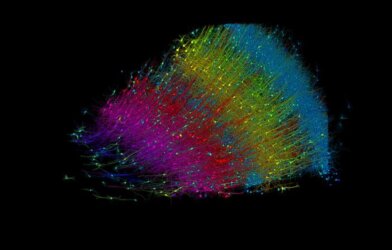The human brain lights up when we hear singing, scientists at the Massachusetts Institute of Technology report. Researchers uncovered a group of neurons that come alight when we hear singing — but not when we hear other types of music.
The neurons, which are found in the auditory cortex, appear to respond to the specific combination of voice and music. Strangely, though, regular speech or instrumental music does not yield the same response. Researchers say they do not know exactly what the neurons are doing.
In 2015, the same MIT research team used functional magnetic resonance imaging (fMRI) to identify a group of neurons in the auditory cortex that respond specifically to music. Participants’ brains were scanned as they listened to a collection of 165 sounds, including speech and music as well as other sounds such as finger tapping and dog barking.
From their findings, the authors devised a new method of analyzing that data. This enabled them to find six neural populations with different response patterns, including the music-selective population and another population that responds selectively to speech.
Using electrocorticography to see brain activity
For the new study, the team used recordings of electrical activity taken at the brain’s surface, which gave them more accurate information than the imaging did. The team wanted to get higher-resolution data using a technique called electrocorticography, which allows electrical activity to be recorded by electrodes placed inside the skull.
This new technique allowed the team to pick apart the two groups of neurons. This is a much more precise way of measuring electrical activity in the brain than fMRI, which measures blood flow in the brain as a proxy of neuron activity.
Electrocorticography is not normally performed on humans because it is invasive, but it is often used to monitor people with epilepsy who are about to undergo surgery to treat seizures. Patients are monitored over several days so doctors can work out where their seizures are coming from before operating. During that time patients can take part in studies that allow doctors to measure their brain activity while they are doing certain tasks, if they agree.
Researchers were able to gather data from 15 people over several years. For the study, participants were played the same set of 165 sounds used in the authors earlier fMRI study. Some of them did not respond to any sounds, but many did.
Study authors developed a new way of analyzing statistics to work out the types of neuron that produced the data that was recorded by each electrode. When they applied this analysis, they found some neurons only responded to singing.
The researchers said they did not expect to make the discovery.
Pinpointing neurons activated by singing
For the second part of the study, the team came up with a mathematical method of combining the data from the intracranial recordings with the fMRI data from their 2015 study. This allowed them to better work out where the neurons that responded to singing were, because fMRI can cover a much larger area of the brain.
The song-specific hotspot is at the top of the temporal lobe in the center of the brain. This suggests the neurons may be responding to pitch or the interaction between words and perceived pitch before sending information to other parts of the brain to be processed.
Now the researchers want to work out what aspects of singing are driving these neurons. They are already trying to unearth whether children have music-selective areas in their brains in the hope of finding out how and when these brain regions develop.
“There’s one population of neurons that responds to singing, and then very nearby is another population of neurons that responds broadly to lots of music,” says .ead study author Dr. Sam Norman-Haignere in a statement. “At the scale of fMRI, they’re so close that you can’t disentangle them, but with intracranial recordings, we get additional resolution, and that’s what we believe allowed us to pick them apart. The work provides evidence for relatively fine-grained segregation of function within the auditory cortex, in a way that aligns with an intuitive distinction within music.
“When we applied this method (intracranial recordings) to this data set, this neural response pattern popped out that only responded to singing,” he continues. “This was a finding we really didn’t expect, so it very much justifies the whole point of the approach, which is to reveal potentially novel things you might not think to look for.”
The findings are published in the journal Current Biology.
Article by South West News Service writer Gwyn Wright












